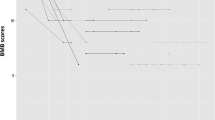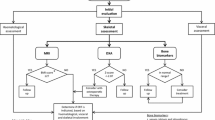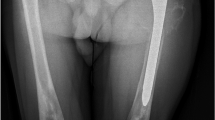Abstract
Gaucher disease (GD) is the most prevalent lysosomal storage disease, and bone involvement is the most disabling condition. The aim of the present study was to evaluate bone involvement in adult patients with GD, using an observational cross-sectional study. Patients were evaluated using X-rays, bone densitometry (BMD), trabecular bone score (TBS), magnetic resonance imaging (MRI), and biochemical bone markers. Thirty-two type 1GD patients were included (mean age: 40 ± 16 years). Patients had received velaglucerase for 2.7 ± 1.4 years; 19/32 had been treated previously with imiglucerase. Ninety-four percent of subjects met therapeutic goals for hematological parameters, and eight were splenectomized (SPX). Nineteen patients had irreversible bone lesions (IL), i.e., avascular necrosis, bone infarction, and/or vertebral fractures. MRI showed marrow infiltration in 71% of patients. Patients with IL had higher bone marrow burden than those without (p = 0.001). All SPX patients had IL, a higher prevalence of bone marrow edema (p = 0.02), and lower TBS (p = 0.03) than non-SPX patients. Only 18.7% of patients had abnormal BMD, with no correlation with fractures (FX). TBS values were < 1350 in 53% of patients and tended to be lower in those with FX (p = 0.06). Patients with P1NP in the lower quartile had lower TBS (p = 0.03) than those with P1NP in the higher quartiles. TBS correlated moderately but not significantly with P1NP (r = 0.32) and BMB (r = − 0.44). A high prevalence of IL was documented. Bone quality was more affected than BMD in fracture patients. Low bone formation, active bone marrow infiltration, and splenectomy might be implicated in IL.
Similar content being viewed by others
References
Stirnemann J, Belmatoug N, Camou F, Serratrice C, Froissart R, Caillaud C et al (2017) A review of Gaucher disease pathophysiology, clinical presentation and treatments. Int J Mol Sci 18:441
Futerman AH, Sussman JL, Horowitz M, Silman I, Zimran A (2004) New directions in the treatment of Gaucher disease. Trends Pharmacol Sci 25:147–151
Horowitz M, Zimran A (1994) Mutations causing Gaucher disease. Hum Mutat 3:1–11
Drelichman G, Linares A, Villalobos J, Cabello JF, Kerstenetzky M, Kohan RM, Martins AM. (2012) Gaucher disease in Latin America. A report from the Gaucher Disease International Registry and the Latin American Group for Gaucher Disease. Medicina 72:273–82
Deegan PB, Pavlova E, Tindall J et al (2011) Osseous manifestations of adult Gaucher disease in the era of enzyme replacement therapy. Medicine (Baltimore) 90:52–60
Marcucci G, Zimran A, Bembi B et al (2014) Gaucher disease and bone manifestations. Calcif Tissue Int 95:477–494
Giraldo P, Solano V, Pérez-Calvo JI, Giralt M, Rubio-Félix D, Spanish Group on Gaucher disease (2005) Quality of life related to type 1 Gaucher disease: Spanish experience. Qual Life Res 14(2):453–462
Wenstrup RJ, Roca-Espiau M, Weinreb NJ, Bembi M (2002) Skeletal aspects of Gaucher disease: a review. Br J Radiol 75(1):A2–A12
Genant HK, Wu CY, van Kuijk C et al (1993) Vertebral fracture assessment using a semiquantitative technique. J Bone Miner Res 8:1137–1148
https://www.iscd.org/official-positions/2nd-iscd-pediatric-position-development-conference/
https://www.iscd.org/official-positions/6th-iscd-position-development-conference-adult
Silva BC, Leslie D, Resch H et al (2014) Trabecular bone score: a noninvasive analytical method based upon the DXA image. J Bone Miner Res 29:518–530
Maas M, van Kuijk C, Stoker J et al (2003) Quantification of bone involvement in Gaucher disease: MR imaging bone marrow burden score as an alternative to dixon quantitative chemical shift MR imaging–initial experience. Radiology 229(2):554–561
Bondar C, Mucci J, Crivaro A, Ormazabal M, Ceci R, Oliveri B, González D, Rozenfeld P (2017) In vitro osteoclastogenesis from Gaucher patients’ cells correlates with bone mineral density but not with chitotriosidase. Bone 103:262–269
Drelichman G, Fernández Escobar N, Basack N et al (2015) Argentina Gaucher disease consensus update: Argentine group for diagnosis and treatment of Gaucher disease. Hematologia 19:4–51
van Dussen L, Biegstraaten M, Dijkgraaf MGW, Hollak CEM (2014) Modelling Gaucher disease progression: long term enzyme replacement therapy reduces the incidence of splenectomy and bone complications. Orphanet J Rare Dis 9:112
Andrade-Campos M, Valero E, Roca M, Giraldo P (2018) On behalf of the, Spanish group on Gaucher disease: the utility of magnetic resonance imaging for bone involvement in Gaucher disease. Assessing more than bone crises blood cells, Mol Dis 68: 126–134
Kaplan P, Andersson HC, Kacena K, Yee JD (2006) The clinical and demographic characteristics of nonneuronopathic Gaucher disease in 887 children at diagnosis. Arch Pediatr Adolesc Med 160:603–608
Drelichman G, Fernández Escobar N, Basack N et al (2016) Skeletal involvement in Gaucher disease: an observational multicenter study of prognostic factors in the Argentine Gaucher disease patients. Am J Hematol 91:E448–E453
Mikosch P, Hughes D (2010) An overview on bone manifestations in Gaucher disease. Wien Med Wochenschr 160:609–624
Khan A, Hangartner T, Weinreb NJ et al (2012) Risk factors for fractures and avascular osteonecrosis in type 1 Gaucher disease: a study from the International Collaborative Gaucher Group (ICGG) Gaucher registry. J Bone Miner Res 27:1839–1848
Melton LJ, Atkinson EJ, Cooper C, O´Fallon WM, Riggs BL (1999) Vertebral fractures predict subsequent fractures. Osteoporos Int 10:214–221
Harvey N, Dennison E, Cooper C (2013) The epidemiology of osteoporotic fractures. In: Rosen C (ed) Primer on the metabolic bone diseases and disorders of mineral metabolism, 8th edn. Wiley-Blackell, New Jersey, pp 348–356
Crary S, Buchanan G (2009) Vascular complications after splenectomy for hematologic disorders. Blood 114:2861–2868
Mucci JM, Rozenfeld P (2015) Pathogenesis of bone alterations in Gaucher disease: the role of immune system. J Immunol. https://doi.org/10.1155/2015/192761
Kanis JA (2002) Diagnosis of osteoporosis and assessment of fracture risk. Lancet 359(9321):1929–1936
Hans D, Goertzen AL, Krieg MA, Leslie WD (2011) Bone microarchitecture assessed by TBS predicts osteoporotic fractures independent of bone density: the Manitoba study. J Bone Miner Res 26:2762–2769
Harvey NC, Glüer CC, Binkley N, McCloskey EV, Brandi ML, Cooper C et al (2015) Trabecular bone score (TBS) as a new complementary approach for osteoporosis evaluation in clinical practice: a consensus report of a European Society for Clinical and Economic Aspects of Osteoporosis and Osteoarthritis (ESCEO) working group. Bone 78:216–224. https://doi.org/10.1016/j.bone.2015.05.016
Ulivieri FM, Silva BC, Sardanelli F, Hans D, Bilezikian JP, Caudarella R (2014) Utility of the trabecular bone score (TBS) in secondary osteoporosis. Endocrine 7:435–448
Baldini M, Casirati G, Ulivieri FM, Cassinerio E, Chalouhi KK, Poggiali E et al (2018) Skeletal involvement in type 1 Gaucher disease: not just bone mineral density. Blood Cells Mol Dis 68:148–152. https://doi.org/10.1016/j.bcmd.2017.06.003
Herrera S, Perez-Lopez J, Molto-Abad M, Guerri-Fernandez G, Cabezudo E, Novelli S et al (2017) Assessment of bone health in patients with type 1 Gaucher disease using impact microindentation. J Bone Miner Res 32:1575–1581
Parisi MS, Mastaglia SR, Bagur A, Goldstein G, Zeni SN, Oliveri B (2008) Body composition and bone metabolism in young Gaucher disease type I patients treated with imiglucerase. Eur J Med Res 13:31–38
van Dussen L, Lips P, Everts VE et al (2011) Markers of bone turnover in Gaucher disease: modeling the evolution of bone disease. J Clin Endocrinol Metab 96:2194–2205
Giuffrida G, Cingari M, Parrinello N et al (2012) Bone turnover markers in patients with type 1 Gaucher disease. Hematol Rep 4:e21. https://doi.org/10.4081/hr.2012.e21
Panicker LM, Srikanth MP, Castro-Gomes T, Miller D, Andrews NW. Feldman RA (2018) Gaucher disease iPSC-derived osteoblasts have developmental and lysosomal defects that impair bone matrix deposition. Hum Mol Genet 27:811–822. https://doi.org/10.1093/hmg/ddx442
Mistry PK, Liu J, Yang M, Nottoli T, McGrath J, Jain D et al (2010) Glucocerebrosidase gene-deficient mouse recapitulates Gaucher disease displaying cellular and molecular dysregulation beyond the macrophage. Proc Natl Acad Sci USA 107:19473–19478
Reed M, Baker RJ, Mehta AB, Hughes D (2013) Enhanced differentiation of osteoclasts from mononuclear precursors in patients with Gaucher disease. Blood Cells Mol Dis 51:185–194
Mucci M, Scian R, De Francesco PN et al (2012) Induction of osteoclastogenesis in an in vitro model of Gaucher disease is mediated by T cells via TNF-α. Gene 509:51–59. https://doi.org/10.1016/j.gene.2012.07.071
Lai JKC, Robertson PL, Goh C, Szer J (2018) Intraobserver and interobserver variability of the bone marrow burden (BMB) score for the assessment of disease severity in Gaucher disease, possible impact of reporting experience. Blood Cell Mol Dis 68:121–125
Vasikaran S, Eastell R, Bruyere O, Foldes AJ, Garnero P, Griesmacher A et al (2011) Markers of bone turnover for the prediction of fracture risk and monitoring of osteoporosis treatment: a need for international reference standards. Osteoporos Int 22:391–420. https://doi.org/10.1007/s00198-010-1501-1
Acknowledgements
The authors thank the following haematologists who collaborated in the recruitment of the patients: Arizo A, Aznar M, Bolesina M, Fernandez Sasso D., Fernandez V, Fondevila C, Guelbert N, Meschengeiser S, Murieda B, Navarro G, Onelda G, Rocaspana A, Romero Maciel A, Ruiz A., Santini F, Sanchez G, Stivel M, Watman N.
Author information
Authors and Affiliations
Contributions
OB participated in the study design, acquisition and analysis of data, and drafting and revision of the manuscript. GD participated in the acquisition and analysis of data and drafting and revision of the manuscript. SC and QF participated in acquisition of data, RP participated in acquisition of data and critical review of the manuscript.
Corresponding author
Ethics declarations
Conflict of interest
Beatriz Oliveri, Diana González, and Paula Rozenfeld have received speaking honoraria from Shire; Felisa Quiroga and Claudio Silva declare no conflict of interest.
Human and Animal Rights and Informed Consent
This study was approved by the Ethical Committee of IBYME (Instituto de Biología y Medicina Experimental, Argentina). All patients or their guardians provided written informed consent to participate in this study.
Additional information
Publisher’s Note
Springer Nature remains neutral with regard to jurisdictional claims in published maps and institutional affiliations.
Rights and permissions
About this article
Cite this article
Oliveri, B., González, D., Quiroga, F. et al. A Comprehensive Study of Bone Manifestations in Adult Gaucher Disease Type 1 Patients in Argentina. Calcif Tissue Int 104, 650–657 (2019). https://doi.org/10.1007/s00223-019-00536-x
Received:
Accepted:
Published:
Issue Date:
DOI: https://doi.org/10.1007/s00223-019-00536-x




